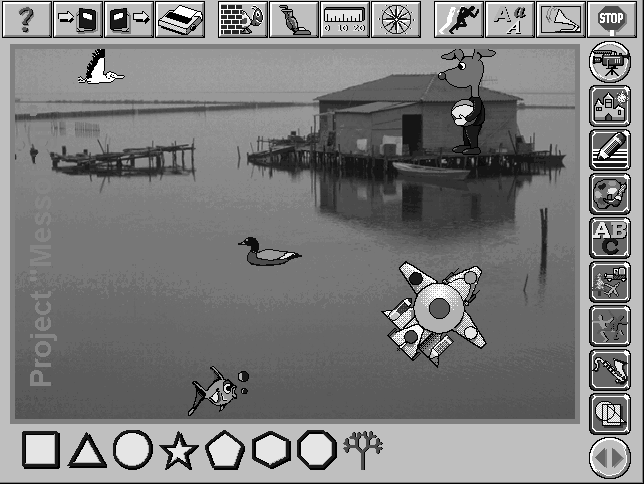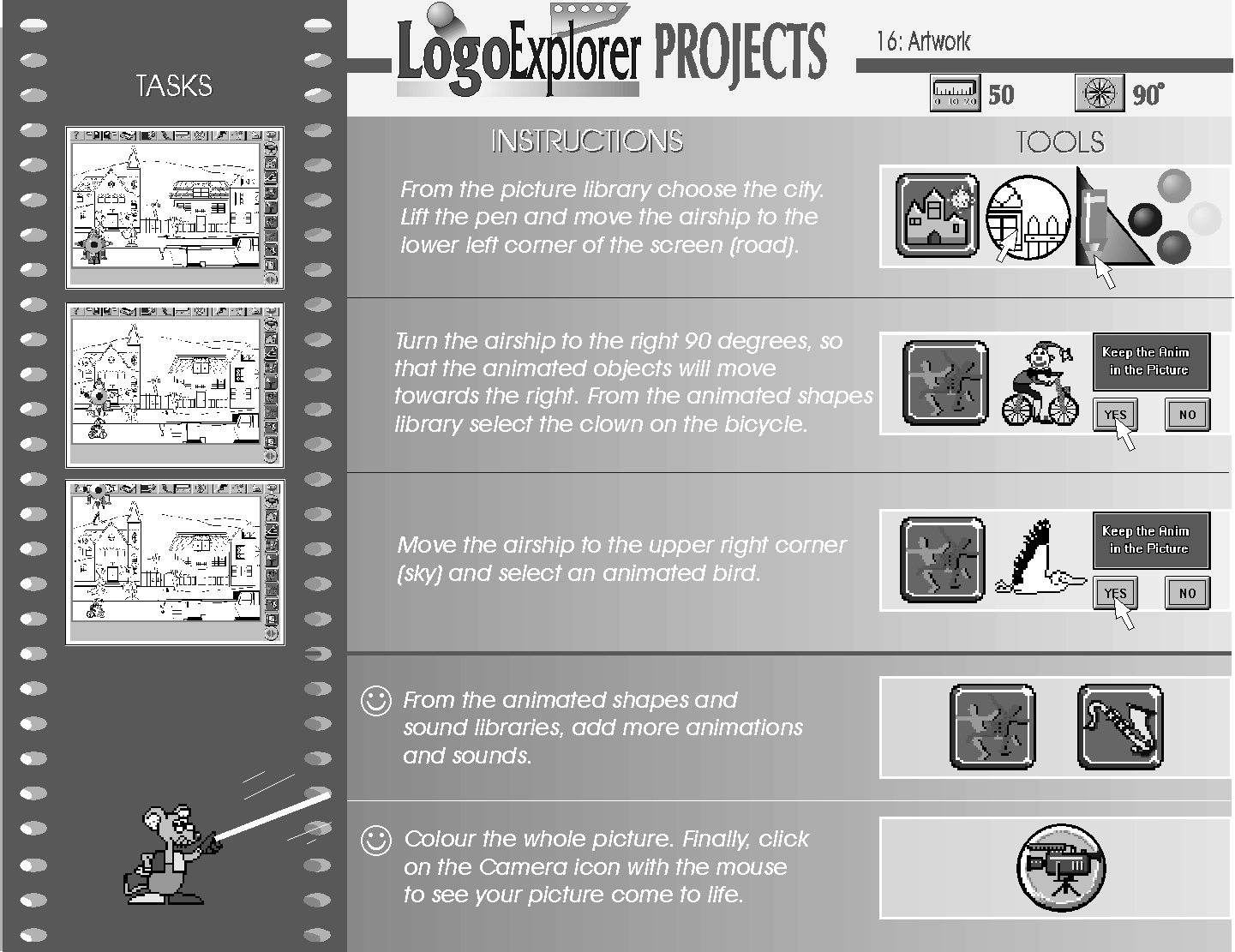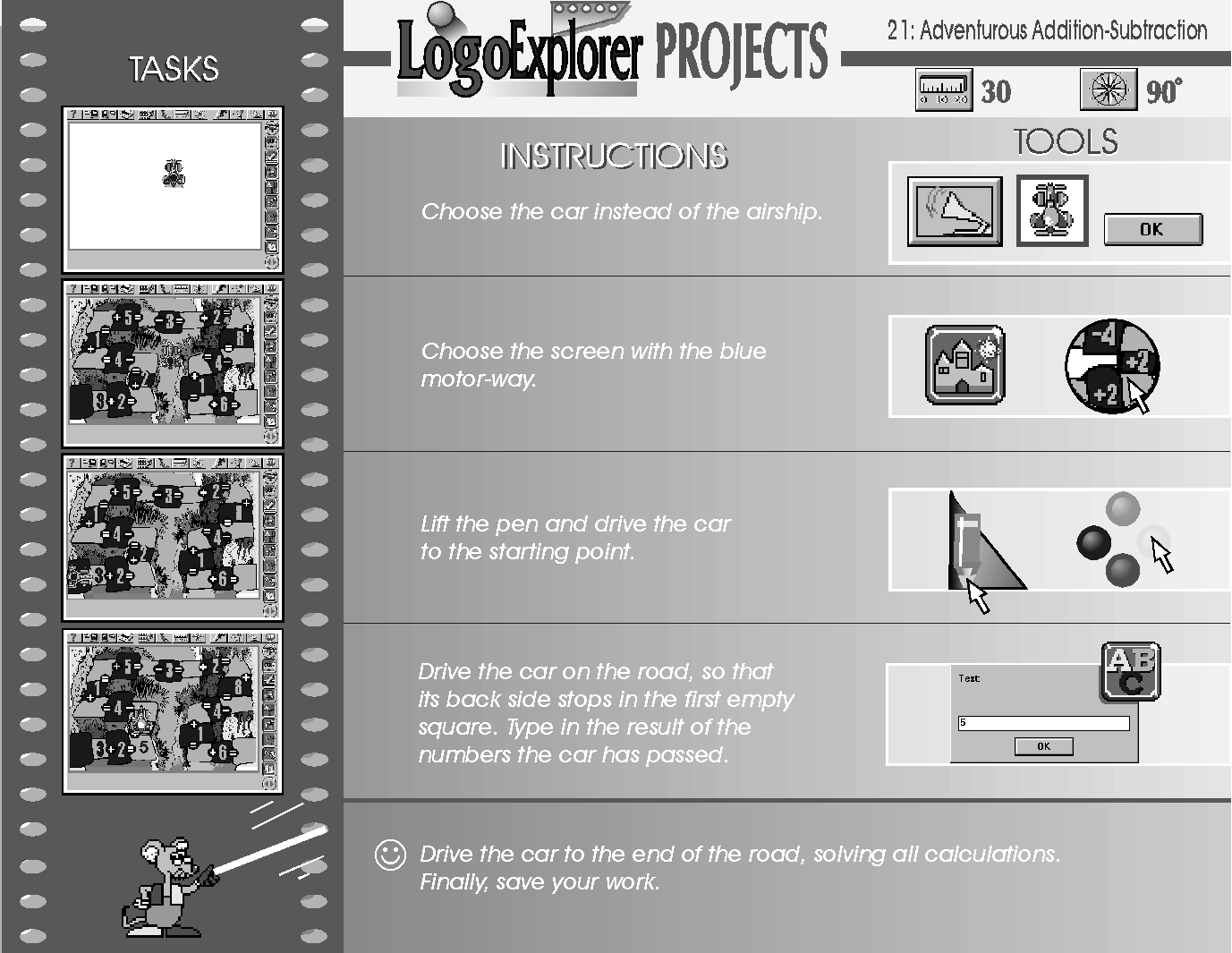
Space - Book - Screen:
Exploring Developmental Microworlds
S. Triantafillou, Y. Kotsanis
Pliroforiki Technognosia
11B Konitsis Str., Maroussi, 15125
tel: 6125880-1, fax: 6125882
email: stathis@multiland.gr
Abstract
Intellectual messages of the real world are better conceived while interacting with Robotics. Reading stimulates imagination and promotes language skills while computer based environments support learning and enable the manipulation of information Space, Book and Screen as exploratory tools may contribute to a child’s development. The present paper tries to structure a developmental logo curriculum utilizing these three interactive sources to promote programmable thought. In particular, the user interface of ‘Roamer’ (a self-driven floor turtle) was modified in such a way as to enable interaction between robot and children within the framework of a structured curriculum. A book "The Explores of the Universe" was designed to encourage programmable thought through cartooning and sticker pasting. Finally, "LogoExplorer", an educational logo based type of software with its project oriented approach (project cards) completed the developmental schema. This schema initiated successive steps towards the integration of children into the world of new technology and at the same time helped them to experience and to assimilate programming thinking.
Keywords
exploratory learning, multimedia, Logo, programming, floor turtle, activity book, microworlds, early ages.
1 Introduction
The world "Programming" definitely does not belong only to the computer environment. It refers to a series basic activities that the human race has successively build up in order to cope with the demands of life. Furthermore the educational and social systems and the structures of today’s life, require more programming activities and life style.
Logo undoubtedly indirectly contributes positively in this schema of life by encouraging and reinforcing programming techniques which address not only the educational needs of students but also support behaviourally the programming demands of today’s society. However because the demands are so intensive numerous and repetitive, programming environments especially for children have to be attractive and motivating, otherwise become boring and uninterested.
Being working with Logo and Children the past ten year we came across many dilemmas about the nature and the quality of open-ended environments. As educationalists although we are aware that the environment is pedagogically quite strong, the interface and the structure of the project oriented work had to be modified and enriched.
In the process of designing educational software for children we realised the need for providing users with a dynamic Logo-like environment incorporating learning schemes and structuring an interactive developmental curriculum which contains computer and non-computer environment. Actually the designing is compatible with the various cognitive stages of costructivism. The basic core of the planned developmental schema is the concept from "concrete to abstract" and incorporates ideas and practices of techniques already applied in the past and some new innovative features.
The interactive developmental environment proposes as a beginning activity the three dimensional living space and utilises a commercial robot in order to provide users with a well defined project oriented work. The next activity refers to a unique book which allows users to read a story and program actions by placing stickers in order. And the final activity on the screen employs the LogoExplorer applications that was developed exclusively for early ages.
The above three activities, space, book and screen consist the milestones of the proposed environment for educationalists and should be assigned in order, or independently.
2 Space
We had the opportunity to try several floor turtles the past years. Long ago we worked with the Endinburgh turtle, then we possessed the Valiant and lately we have being working with Roamer. Designing a Children’s environment with the floor turtle we had quite few difficulties with the first two turtles because the control was via the keyboard therefore the timing of cause and effect was slightly delayed. Roamer provides an ideal direct control, able to operate independently.
However Roamer’s interface is quite complicated for early ages, there are buttons that are related to operations not suitable for these ages. We tried to design our own robot but still have some difficulties that we could not overpass. Therefore we modified Roamer’s interface by covering with stickers the unwanted buttons and by placing stickers of a relative program (LogoExplorer) on the desired buttons.

Of course we are not very happy with the operation of turning left / right which is expressed with the combination of two numbers but we tried to solve that through the surrounding environment.
The floor turtle alone is too plain in order to motivate children to interact with, thus we designed a stimulating technological environment for the space stage, the Pre-schoolers Explorers. The Pre-schoolers Explorers contains the modified Roamer, the interface cards in the Learning cards and it follows the developmental pattern bellow:
Prestage: General Preparation and discussion with the users.
Stage 1: Initiation into robot movements teaching the interface /commands. Moving freely in space.
Stage 2: Project oriented work with Learning cards. The cards contain Learning items referring to basic concepts curriculum i.e., colour, number, objects and shape cards. Are placed beneath a plexi glass on which the turtle moves. The instructor first and the children after could organise their own exercises by structuring cognitive mazes.
Stage 3: Parallel work with interface cards. These cards contain the commands of the LogoExplorer i.e. the basic commands of one key-logo and are placed gradually besides the work area (plexi glass) forming elementary programs of the users.
3 Book
The book is still the best friend of the student specially when it is paired with cartooning. On the other hand the book is approaching greater number of students due to low-cost compare to computers. The aim behind the designing of the book "The Explores of the Universe" was to provide a wide range of users with a book, that will enable them to program in a Logo-like environment without the need of the machine.
The idea is simple, the scenario of the book tells the story of LogoExplorers (human-like characters from out space) that undertake a mission from the supreme council of their planet (Multiland) to travel in space looking for the "Lost Knowledge". Inside the big space craft the council and the LogoExplorers interact creatively trying to complete each mission.
|
|
The reader (user) is asked by the story, after getting introduced into the environment of commands, to "help" logo explorers in their mission by understanding the assigned paths and tasks and by composing small programs by placing stickers in order.

The user is reading the story and then gets the appropriate stickers from the stickers card and pastes them in the relative work area so at the end has a detailed presentation of the program. The book also contains a co-operative game relative to the philosophy of the environment.
4 Screen
The transference from the 3D floor-turtle environment to the 2D screen turtle environment was responsible for the disconnection of the child from the immediate control of the turtle due to the change in the user interface. Trying to cope with this and in order to complete the developmental schema we designed the environment of LogoExplorer which includes the powerful microworld of the visual robot. The child directs the visual robot (a caretta - caretta turtle, a formula car, a multiman hero or a spaceship,) by clicking the mouse on the head (forward), tail (backward), front legs (left/right).

This environment enables the child to fully identify himself with the turtle body and to control its movement. Pen up and pen down is placed on the right back leg of the turtle and pen erase on the left one, while her body is the window of the button-libraries which are located on the right side to the screen. From the libraries the child is able to select:
At the time when the child selects an activity, a number of selections appears on the turtles body.
The library menu is also equipped with a button that shows the library selections by tenths of each one successively either in the turtles body or along the bottom of the screen. At the desired selection the child clicks on the turtle body or on the bottom screen selection and he/she selects the particular picture. So the child is able to draw, colour, stamp shapes, put heroes, animated shapes, sounds and melodies on the screen. Completing his/her design, and by pressing the camera button RUN, the design comes alive, the colours are cycling, the heroes are running and sounds melodies complete the grand finale.
The program’s menu is located horizontally on the top of the screen, including functions such as help, save, load, clear screen, changing steps and angles of the turtle, drawing circles and terminating an activity.

Being an open-ended environment there is a need to support LogoExplorer with a project oriented work. Therefore we designed a developmental series of projects cards which introduce successively the commands of the system and provide Logo experiences through curriculum oriented work. Specifically, each project card states the number and the thematic area of the project (i.e. 21: Adventures Addition-Subtraction), as well as the size of steps and angles which the relative project utilises. Additionally each project card is divided into four sections. The first section contains the Tasks of the project which is a set of screens showing gradually the evolution of the project. The second section contains short instructions relative to the screen besides, The third section contains the set of tools which is required in order to design the particular screen. Therefore the Screen, the instructions and the tools, which belong horizontally in the same line, consist each Work Step of the project. Finally the fourth section requires from the user additionally actions of the project and does not provide any information.
The aim of the project in the LogoExplorer is to engage the student creatively in project oriented work and to stimulate his/her interests about Logo and how the program could curriculum. It is expected that upon the completion of the series the student will be motivated enough to proceed by designing his/her own works.


The ultimate goal of Logo always has being the direct manipulation of the turtle, for Pre-schoolers and early elementary pupils. Floor turtles offer such an experience although the user interface is not ideal and they are quite expensive. LogoExplorer is the appropriate environment for early ages and turtle graphics. It offers the desirable direct control of the turtle, entails simple user interface on the turtle’s body (providing a visual communication panel with one key commands) and assists the users directly on screen interactivity.
5 Conclusions
The initial intention was to provide young users who engage with computer environments with a Logo developmental curriculum highly interactive in order to stimulate programmable thought. On the way to this goal we realized that we actually structured autonomous microworlds which could be assigned developmentally as well as be independently.
We tried very hard to install functional and innovative characteristics in the existing environment of Logo. However some times we were not able to overpass the obstacles, as is the case with the robot’s user interface. Other times the project’s new ideas had impressive results, as is the case with the stickers pasting and direct control of the LogoExplorer. An additional benefit of the project is that the structured curriculum provides alternative ways of interacting with the Logo concepts. This interdisciplinary approach paired with project oriented work seems to be able to provoke the interests of young users and simultaneously to offer a set of learning tools to educators.
It is expected that further research through actual practice will indicate the functionality of the demonstrators and further developments and modifications will ensure the quality of the environment.
References